Advantages and challenges of the cefr - Aligned learning outcome implementation for non - English major students at hue university
The study was carried out to explore the issues related to the CEFR-aligned
learning outcome implementation for non-English major students at Hue University. Its
focus was on the advantages and challenges during the implementation process perceived
by general English teachers. Qualitative approach was chosen with the data being collected
by means of in-depth interview. Ten general English teachers who have experienced
teaching non-English major students at Hue University took part in the study. The findings
have shown that the CEFR-aligned learning outcome implementation process for nonEnglish major students at Hue University has gained a number of advantages but still faced
some challenges. The advantages included appropriate teacher training, modern facilities
and resources, teacher sound understanding of the policy, and positive changes in teaching
methodology. The challenges were more related to the imbalance among students’
proficiency, assigned textbooks, teacher-led hours and required learning outcome and
assessment practices.
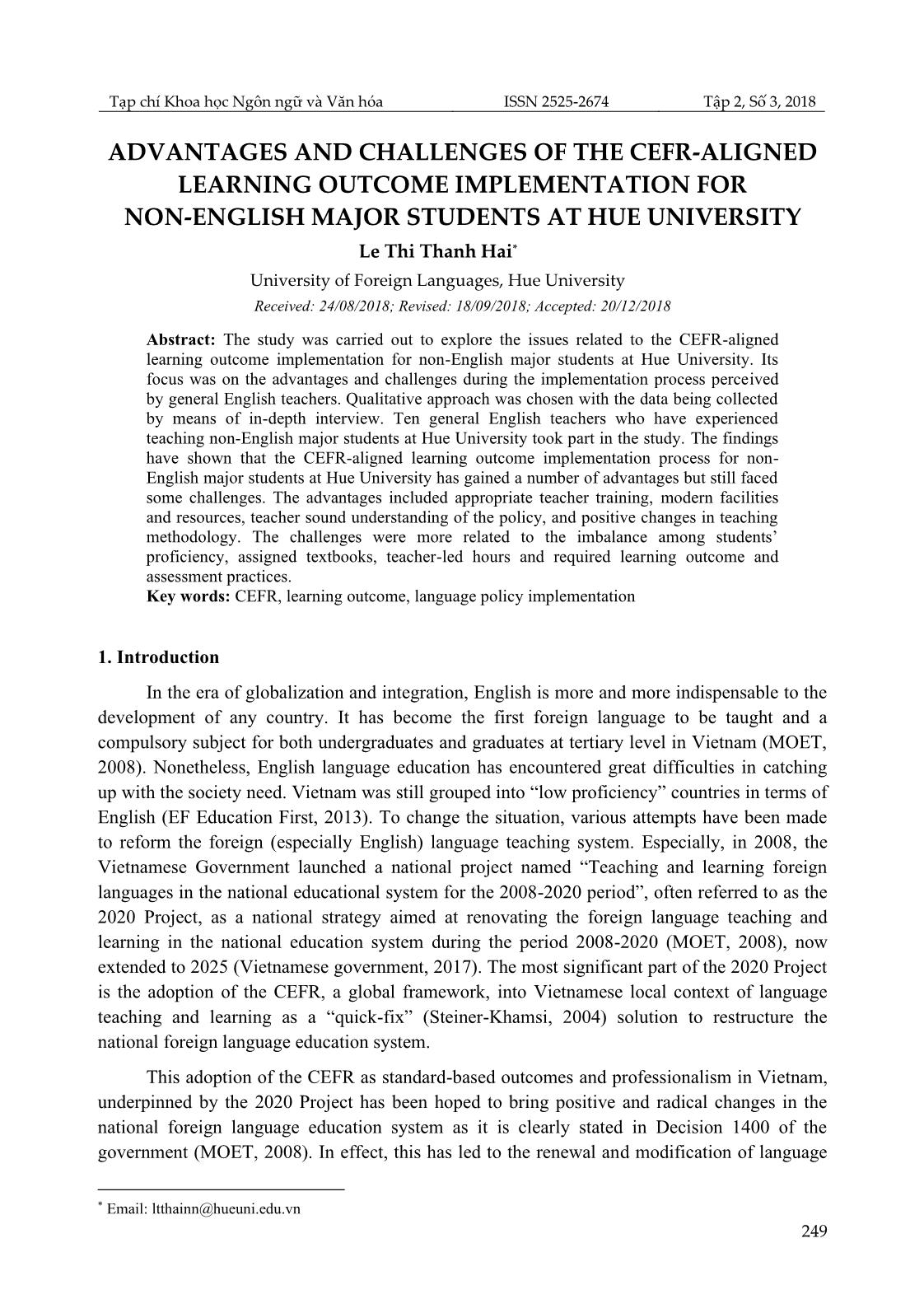
Trang 1
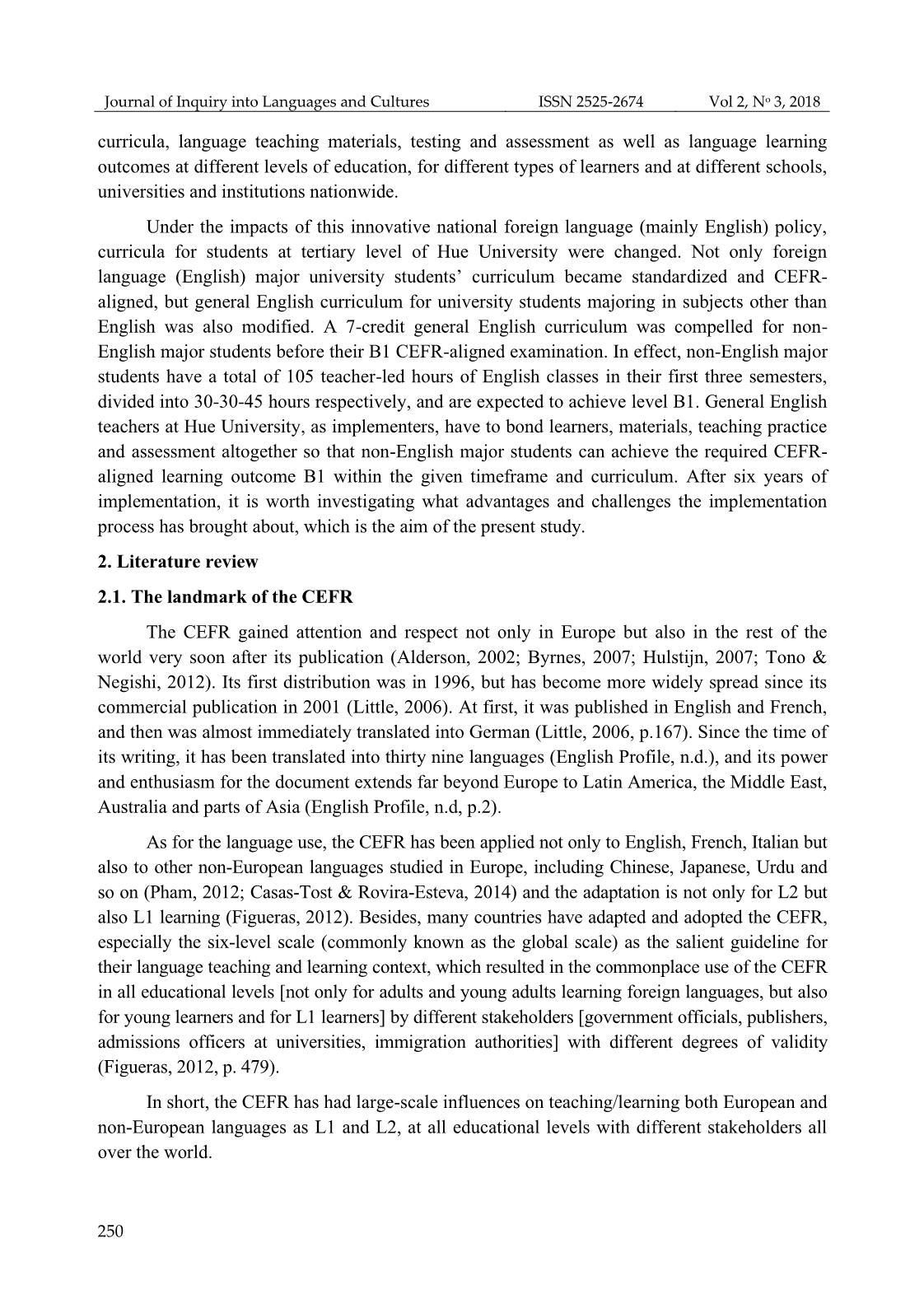
Trang 2
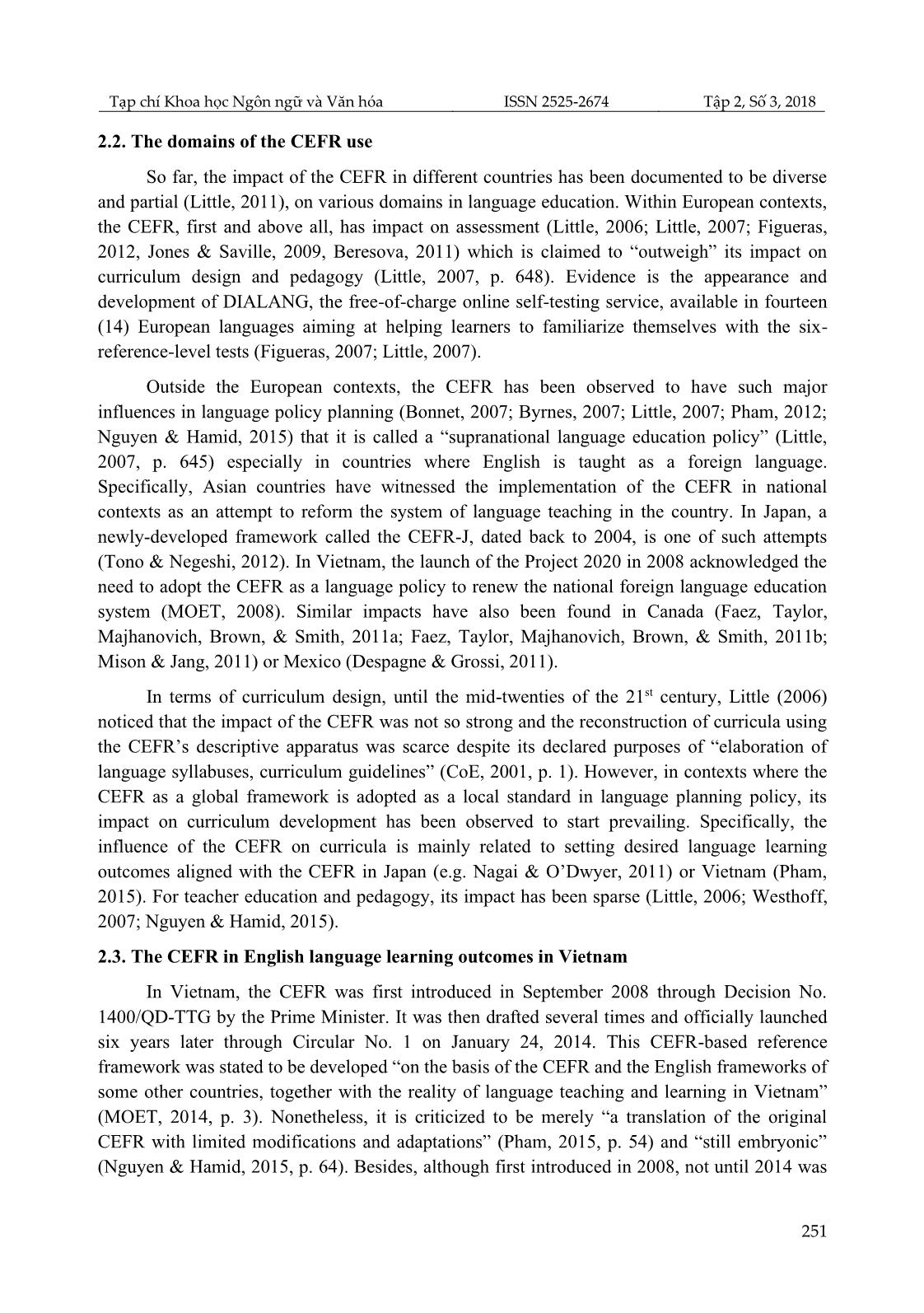
Trang 3
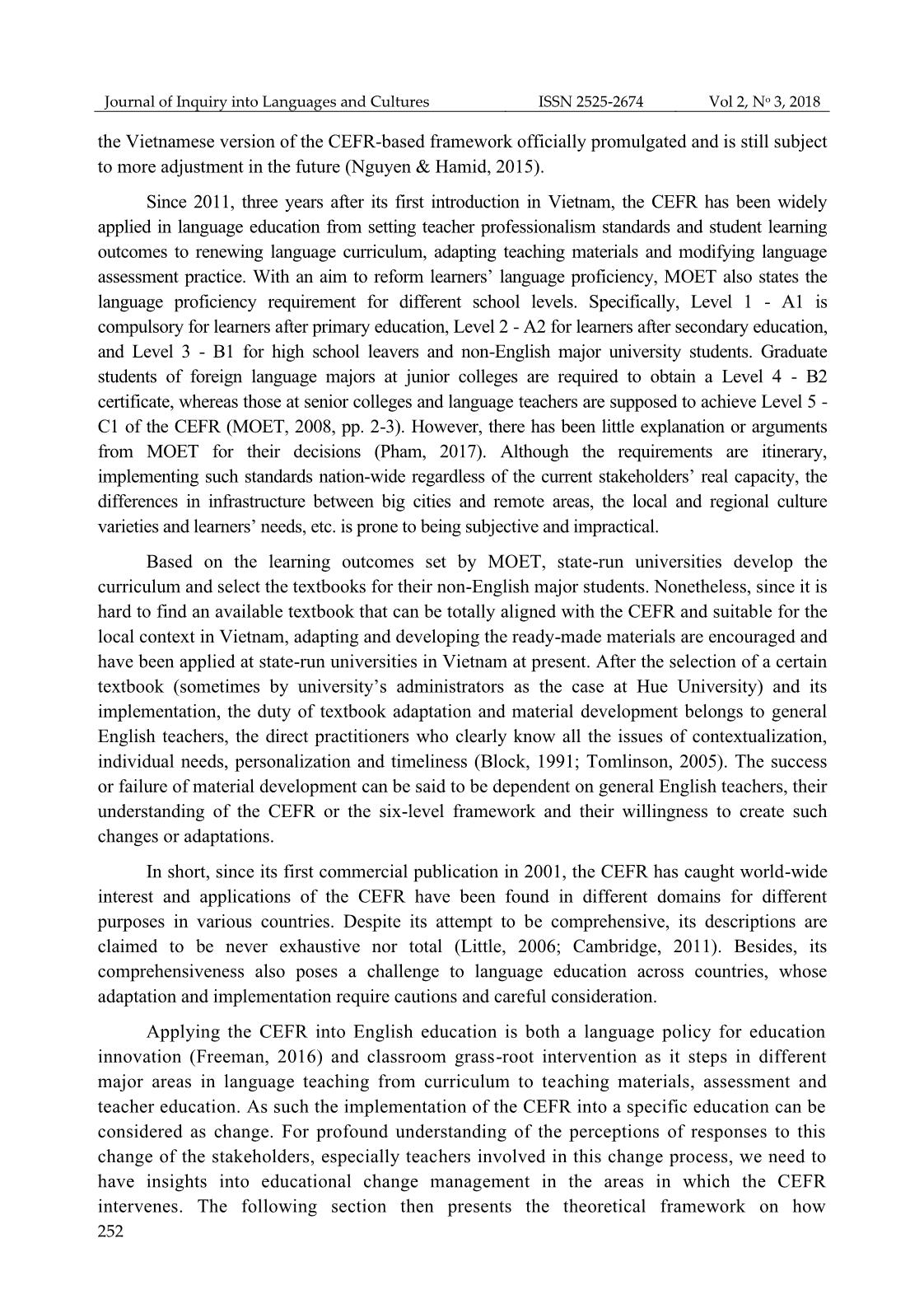
Trang 4
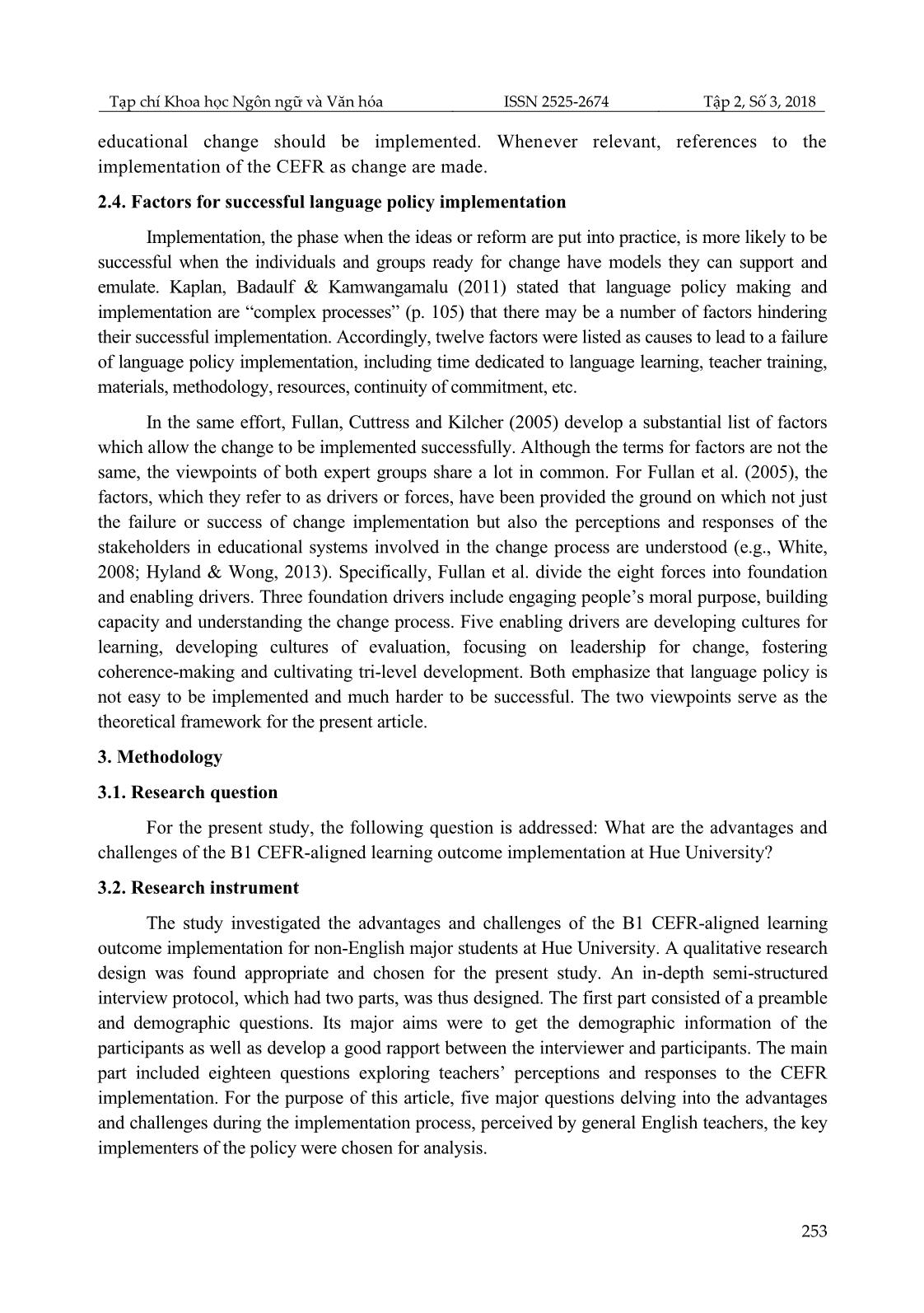
Trang 5
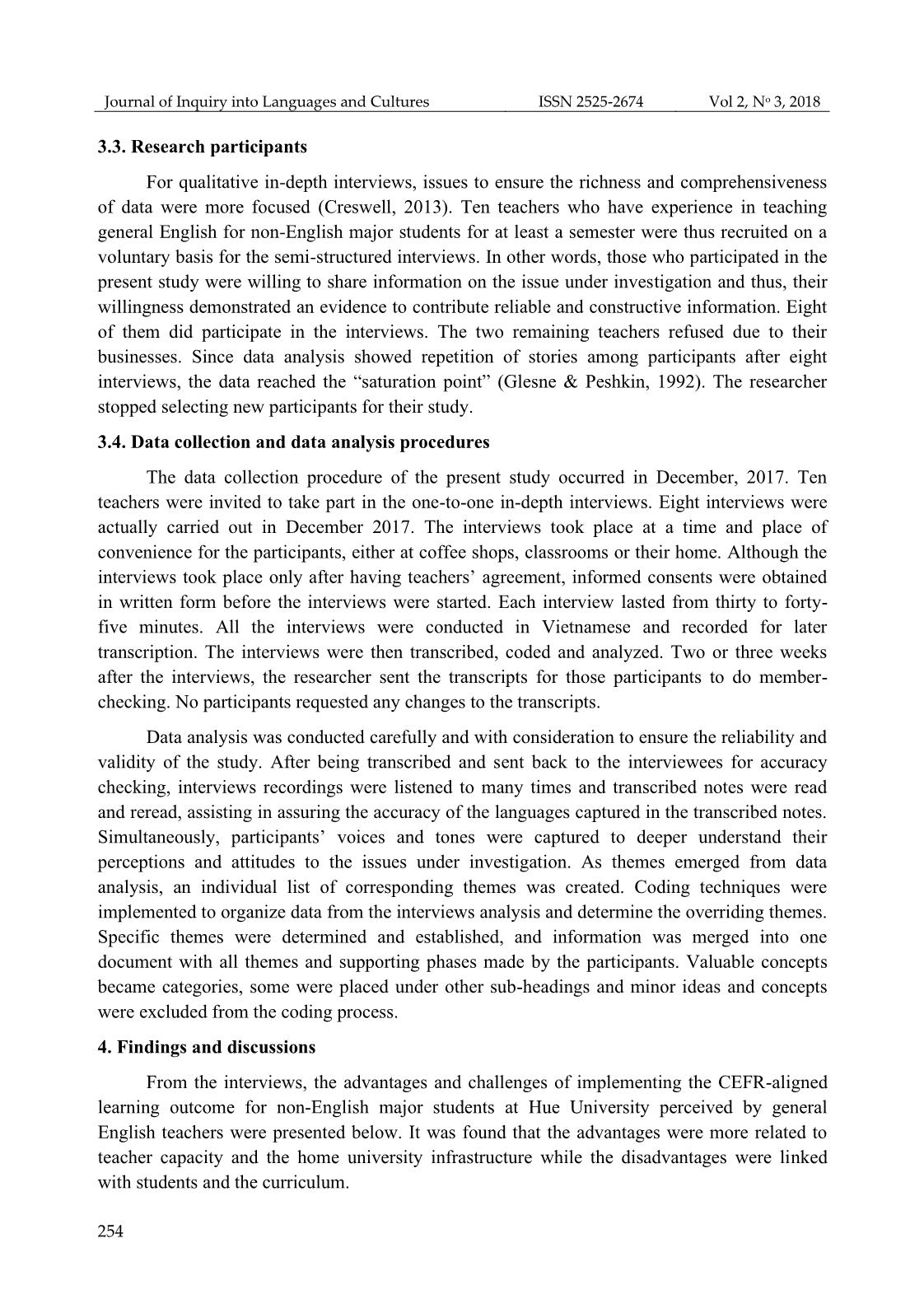
Trang 6
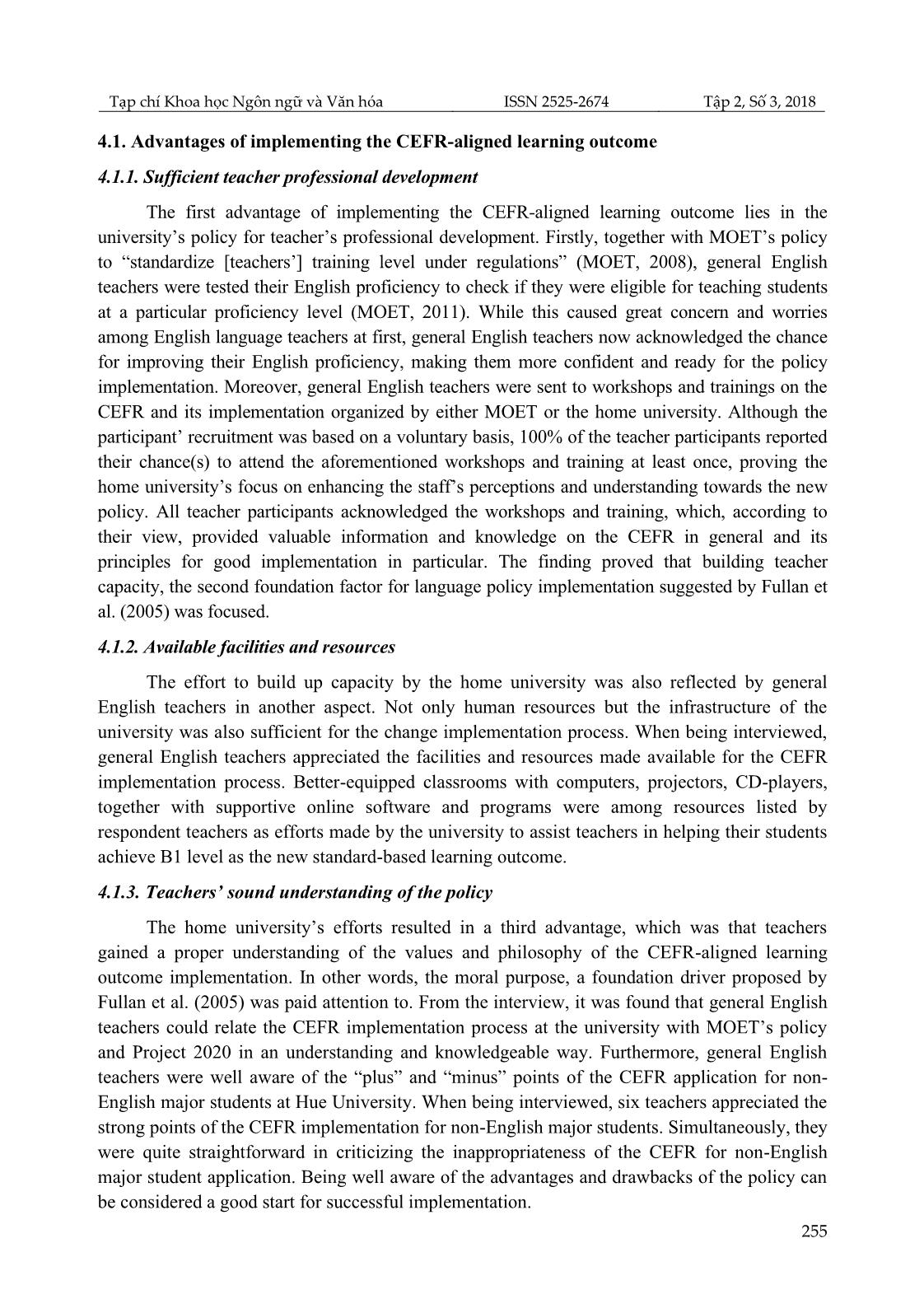
Trang 7
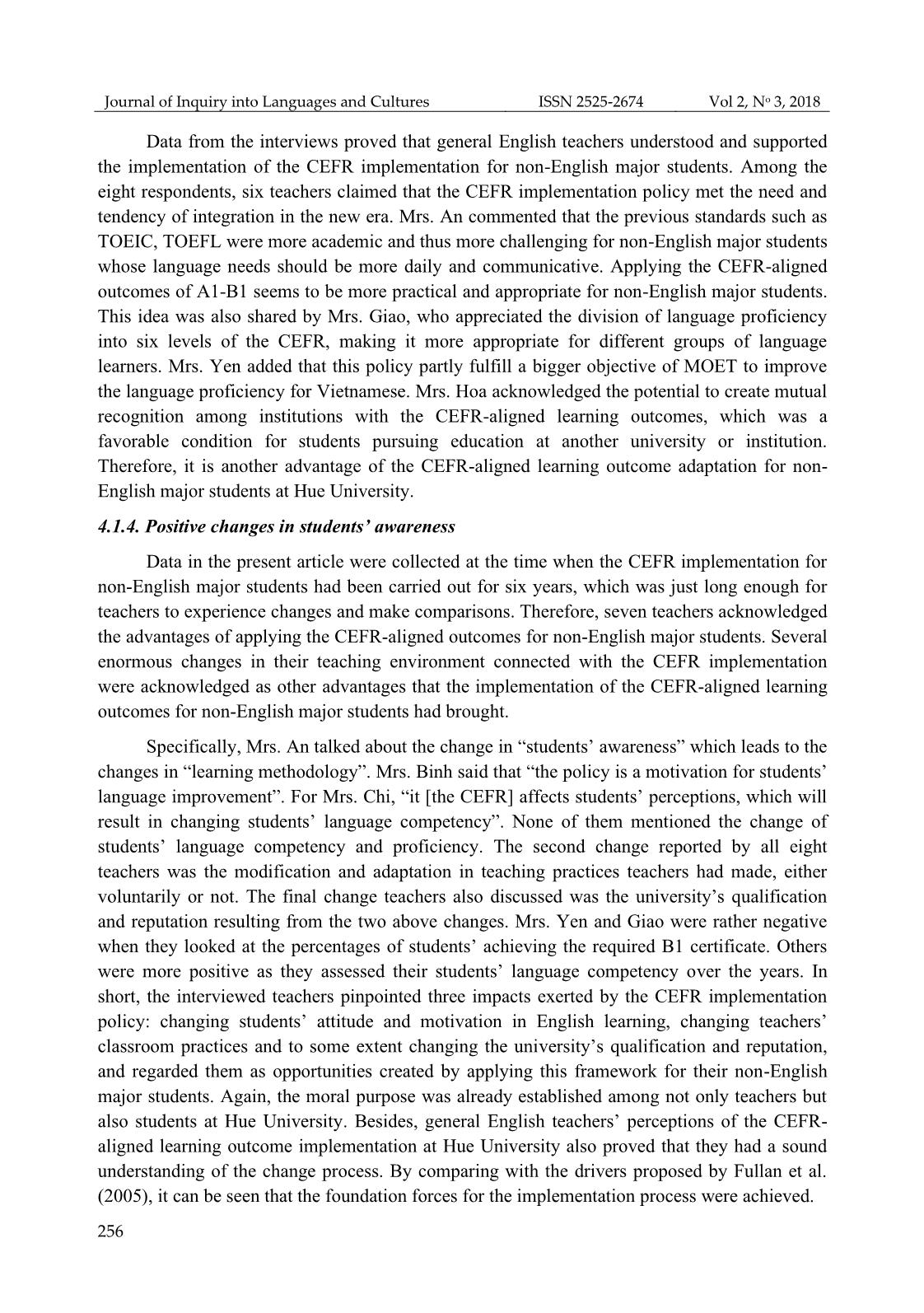
Trang 8
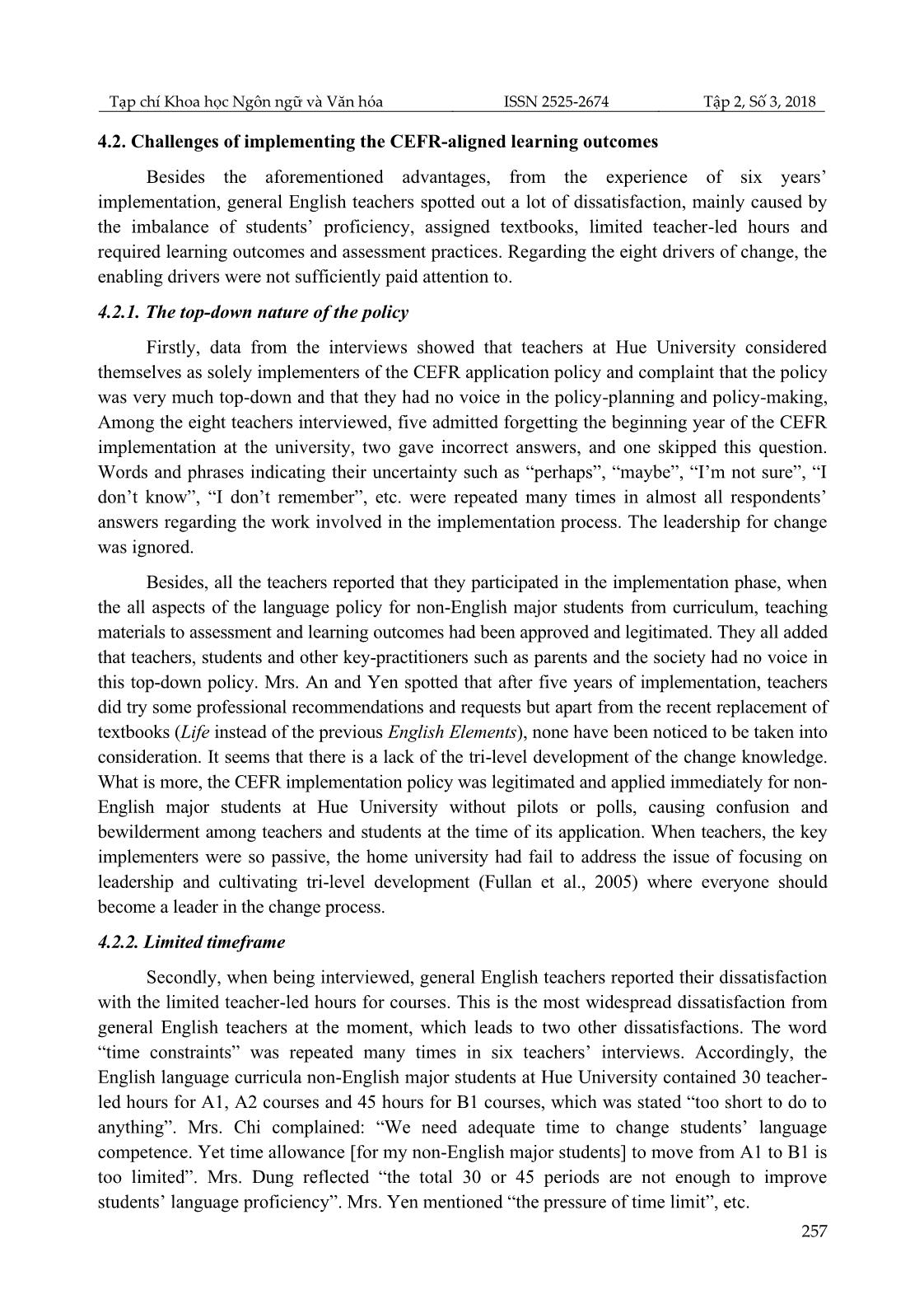
Trang 9
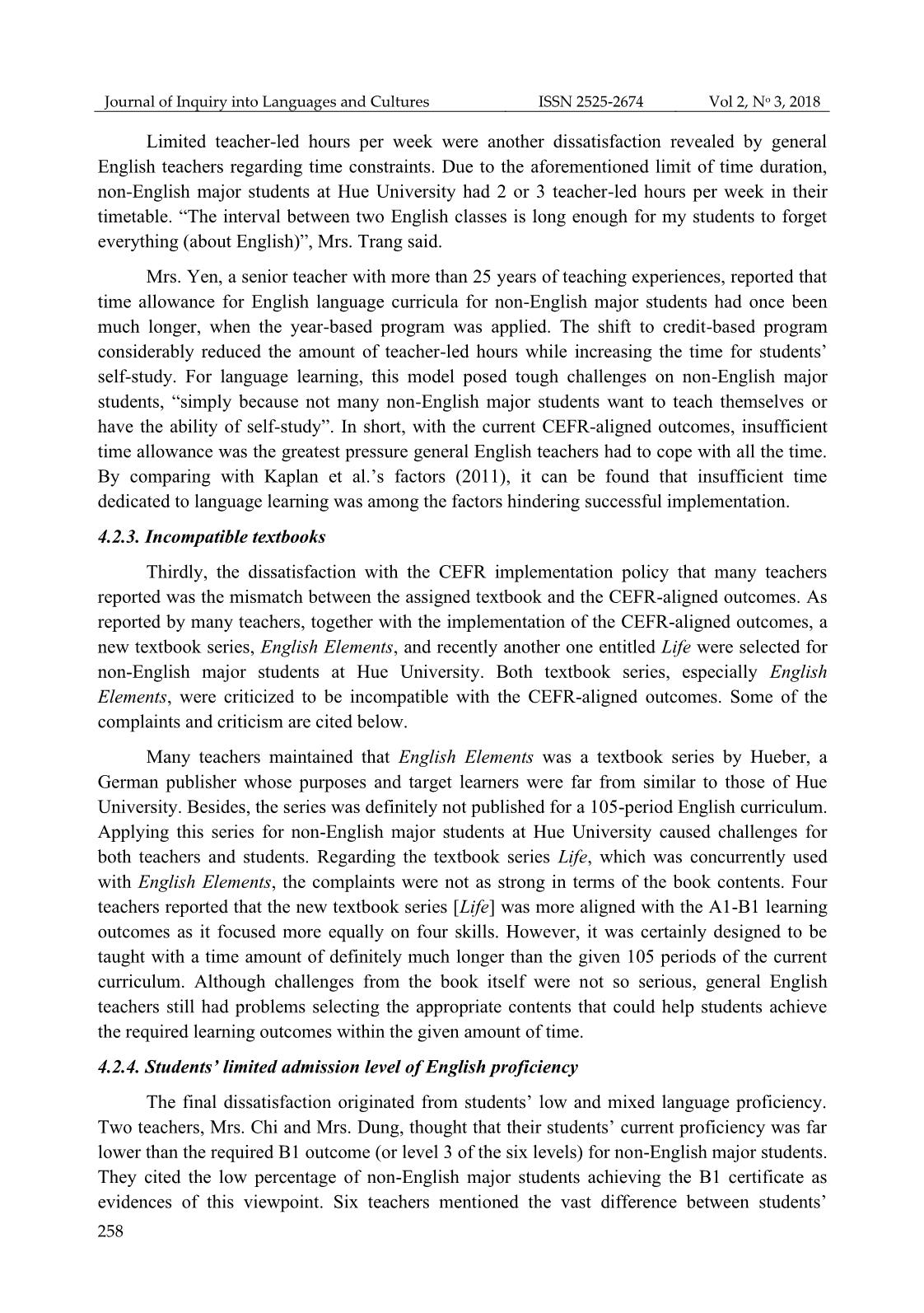
Trang 10
Tải về để xem bản đầy đủ
Tóm tắt nội dung tài liệu: Advantages and challenges of the cefr - Aligned learning outcome implementation for non - English major students at hue university
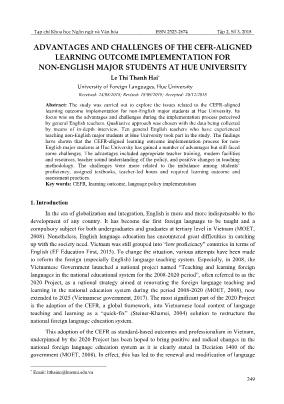
Tạp chí Khoa học Ngôn ngữ và Văn hóa ISSN 2525-2674 Tập 2, Số 3, 2018 249 ADVANTAGES AND CHALLENGES OF THE CEFR-ALIGNED LEARNING OUTCOME IMPLEMENTATION FOR NON-ENGLISH MAJOR STUDENTS AT HUE UNIVERSITY Le Thi Thanh Hai* University of Foreign Languages, Hue University Received: 24/08/2018; Revised: 18/09/2018; Accepted: 20/12/2018 Abstract: The study was carried out to explore the issues related to the CEFR-aligned learning outcome implementation for non-English major students at Hue University. Its focus was on the advantages and challenges during the implementation process perceived by general English teachers. Qualitative approach was chosen with the data being collected by means of in-depth interview. Ten general English teachers who have experienced teaching non-English major students at Hue University took part in the study. The findings have shown that the CEFR-aligned learning outcome implementation process for non- English major students at Hue University has gained a number of advantages but still faced some challenges. The advantages included appropriate teacher training, modern facilities and resources, teacher sound understanding of the policy, and positive changes in teaching methodology. The challenges were more related to the imbalance among students’ proficiency, assigned textbooks, teacher-led hours and required learning outcome and assessment practices. Key words: CEFR, learning outcome, language policy implementation 1. Introduction In the era of globalization and integration, English is more and more indispensable to the development of any country. It has become the first foreign language to be taught and a compulsory subject for both undergraduates and graduates at tertiary level in Vietnam (MOET, 2008). Nonetheless, English language education has encountered great difficulties in catching up with the society need. Vietnam was still grouped into “low proficiency” countries in terms of English (EF Education First, 2013). To change the situation, various attempts have been made to reform the foreign (especially English) language teaching system. Especially, in 2008, the Vietnamese Government launched a national project named “Teaching and learning foreign languages in the national educational system for the 2008-2020 period”, often referred to as the 2020 Project, as a national strategy aimed at renovating the foreign language teaching and learning in the national education system during the period 2008-2020 (MOET, 2008), now extended to 2025 (Vietnamese government, 2017). The most significant part of the 2020 Project is the adoption of the CEFR, a global framework, into Vietnamese local context of language teaching and learning as a “quick-fix” (Steiner-Khamsi, 2004) solution to restructure the national foreign language education system. This adoption of the CEFR as standard-based outcomes and professionalism in Vietnam, underpinned by the 2020 Project has been hoped to bring positive and radical changes in the national foreign language education system as it is clearly stated in Decision 1400 of the government (MOET, 2008). In effect, this has led to the renewal and modification of language * Email: ltthainn@hueuni.edu.vn Journal of Inquiry into Languages and Cultures ISSN 2525-2674 Vol 2, No 3, 2018 250 curricula, language teaching materials, testing and assessment as well as language learning outcomes at different levels of education, for different types of learners and at different schools, universities and institutions nationwide. Under the impacts of this innovative national foreign language (mainly English) policy, curricula for students at tertiary level of Hue University were changed. Not only foreign language (English) major university students’ curriculum became standardized and CEFR- aligned, but general English curriculum for university students majoring in subjects other than English was also modified. A 7-credit general English curriculum was compelled for non- English major students before their B1 CEFR-aligned examination. In effect, non-English major students have a total of 105 teacher-led hours of English classes in their first three semesters, divided into 30-30-45 hours respectively, and are expected to achieve level B1. General English teachers at Hue University, as implementers, have to bond learners, materials, teaching practice and assessment altogether so that non-English major students can achieve the required CEFR- aligned learning outcome B1 within the given timeframe and curriculum. After six years of implementation, it is worth investigating what advantages and challenges the implementation process has brought about, which is the aim of the present study. 2. Literature review 2.1. The landmark of the CEFR The CEFR gained attention and respect not only in Europe but also in the rest of the world very soon after its publication (Alderson, 2002; Byrnes, 2007; Hulstijn, 2007; Tono & Negishi, 2012). Its first distribution was in 1996, but has become more widely spread since its commercial publication in 2001 (Little, 2006). At first, it was published in English and French, and then was almost immediately translated into German (Little, 2006, p.167). Since the time of its writing, it has been translated into thirty nine languages (English Profile, n.d.), and its power and enthusiasm for the document extends far beyond Europe to Latin America, the Middle East, Australia and parts of Asia (English Profile, n.d, p.2). As for the language use, the CEFR has been applied not only to English, French, Italian but also to other non-European languages studied in Europe, including Chinese, Japanese, Urdu and so on (Pham, 2012; Casas-Tost & Rovira-Esteva, 2014) and the adaptation is not only for L2 but also L1 learning (Figueras, 2012). Besides, many countries have adapted and adopted the CEFR, especially ... n short, with the current CEFR-aligned outcomes, insufficient time allowance was the greatest pressure general English teachers had to cope with all the time. By comparing with Kaplan et al.’s factors (2011), it can be found that insufficient time dedicated to language learning was among the factors hindering successful implementation. 4.2.3. Incompatible textbooks Thirdly, the dissatisfaction with the CEFR implementation policy that many teachers reported was the mismatch between the assigned textbook and the CEFR-aligned outcomes. As reported by many teachers, together with the implementation of the CEFR-aligned outcomes, a new textbook series, English Elements, and recently another one entitled Life were selected for non-English major students at Hue University. Both textbook series, especially English Elements, were criticized to be incompatible with the CEFR-aligned outcomes. Some of the complaints and criticism are cited below. Many teachers maintained that English Elements was a textbook series by Hueber, a German publisher whose purposes and target learners were far from similar to those of Hue University. Besides, the series was definitely not published for a 105-period English curriculum. Applying this series for non-English major students at Hue University caused challenges for both teachers and students. Regarding the textbook series Life, which was concurrently used with English Elements, the complaints were not as strong in terms of the book contents. Four teachers reported that the new textbook series [Life] was more aligned with the A1-B1 learning outcomes as it focused more equally on four skills. However, it was certainly designed to be taught with a time amount of definitely much longer than the given 105 periods of the current curriculum. Although challenges from the book itself were not so serious, general English teachers still had problems selecting the appropriate contents that could help students achieve the required learning outcomes within the given amount of time. 4.2.4. Students’ limited admission level of English proficiency The final dissatisfaction originated from students’ low and mixed language proficiency. Two teachers, Mrs. Chi and Mrs. Dung, thought that their students’ current proficiency was far lower than the required B1 outcome (or level 3 of the six levels) for non-English major students. They cited the low percentage of non-English major students achieving the B1 certificate as evidences of this viewpoint. Six teachers mentioned the vast difference between students’ Tạp chí Khoa học Ngôn ngữ và Văn hóa ISSN 2525-2674 Tập 2, Số 3, 2018 259 English language competence and the required learning outcomes, although the situation was different among students of different majors and from different colleges. In conclusion, although the problem may not come from the CEFR and its policy, from the reality of students’ low English level, the policy has caused enormous challenges to both teachers and non-English major students at Hue University. From the viewpoint of implementers, the mismatch between students’ current level of proficiency and the required learning outcome caused the dissatisfaction among general English teachers during the implementation process. Therefore, coherence-making, the seventh driver of change, was not fulfilled. All the aforementioned challenges can be seen as the shortcomings of the CEFR-aligned learning outcome implementation process that has been applied for non-English major students at Hue University. By comparing with Fullan et al’s theoretical framework of change, it can be found that the drawbacks were largely related to the enabling drivers, namely focusing on leadership for change, fostering coherence-making and cultivating tri-level development. 5. Conclusion and implications The results obtained indicated that the CEFR-aligned learning outcome implementation process for non-English major students at Hue University has gained a number of advantages but still faces some challenges. The advantages include appropriate teacher training, available facilities, teachers’ sound understanding of the policy, and positive change in teaching methodology. These fit into the foundation drivers of Fullan et al.’s change theory (2005) regarding the moral purpose engagement, capacity building and change process understanding. The challenges were more related to the imbalance among students’ proficiency, assigned textbooks, teacher-led hours and required learning outcome and assessment practices. Concerning change management theory by Fullan et al. (2005), the implementation failed to address the enabling drivers, namely focusing on leadership for change, fostering coherence-making and cultivating tri-level development. The results of the present study have compelled the implications for practice. Firstly, teachers are the actual deliverers of curriculum across disciplines and across levels. Their instructional practice and educational foundations may vary, but they still remain the key implementers of the curriculum. This suggests that general English teachers and/or non-English major students should be involved in the CEFR-aligned curriculum planning. Therefore, their voices must be acknowledged, listened to and acted upon. Moreover, general English teachers should take initiatives in the implementation process. They should call for understanding and acceptance among students, parents and local community so that the CEFR application becomes more effective. Inside classrooms, they need to perceive themselves as leaders and perform the role of active leaders, not just passive implementers. By realizing the intentions and plans of policy-makers, they act out the policy and spread the leadership to their students and peers, making leadership developed in others on an ongoing basis for sustainable reform (Fullan et al., 2005). There is evidence that capacity building, the second driver for change management pinpointed by Fullan, has been made in preparation for the CEFR implementation. Nonetheless, for capacity building, front-end training is insufficient (Fullan et al., 2005). Teacher training and Journal of Inquiry into Languages and Cultures ISSN 2525-2674 Vol 2, No 3, 2018 260 collaboration ought to become a regular part of teacher professional development because “successful change involves learning during implementation” (Fullan, et al., 2005, p. 55). This offers hints that the home university has planned and continues organizing relevant workshops and trainings for general English teachers. For successful CEFR-aligned learning outcome implementation, the home university should take these issues into careful consideration to make appropriate modifications and adjustments in the coming years. References Alderson, J.C. (2002). Common European framework of reference for languages: Learning, Teaching, Assessment: Case Studies. Strasbourg, France: Council of Europe. Bérešová, J. (2011). The impact of the common European framework of reference on teaching and testing in central and eastern European context. Synergies Europe, 6, 177-190. Block, D. (1991). Some thought on DIY materials design. ELT Journal, 45(3), 211-217. Bonnet, G. (2007). The CEFR and education policies in Europe. The Modern Language Journal, 91(4), 669-672. Byrnes, H. (2007). Developing national language education policies: Reflections on the CEFR. The Modern Language Journal, 91(4), 679-685. Casas-Tost, H., & Rovira-Esteva, S. (2014). New models, old patterns? The implementation of the Common European framework of reference for languages for Chinese. Linguistics and Education, 27, 30-38. Council of Europe (2001). Common European framework of reference for languages: Learning, teaching, assessment. Cambridge: Cambridge University Press. Council of Europe (n.d.). Common European framework of reference for languages: Learning, teaching, assessment. Retrieved on April 12th, 2016 from /linguistic/cadre1_en.asp. Cambridge, E.S.O.L. (2011). Using the CEFR: Principles of good practice. Cambridge ESOL. Creswell, J.W. (2013). Research design: Qualitative, quantitative, and mixed methods approaches. Thousand Oaks, CA: Sage. Despagne, C., & Grossi, J.R. (2011). Implementation of the CEFR in the Mexican Context. Synergies Europe, 6, 65-74. Education First (2013). “EF English proficiency index 2013”, available at: www.ef- australia.com.au/epi/ (accessed 10 August 2015). English Profile (n.d.). What is the CEFR. Retrieved on April 15th, 2016 from Faez, F., Majhanovich, S., Taylor, S., Smith, M., & Crowley, K. (2011a). The power of “Can Do” statements: teachers’ perceptions of CEFR-informed instruction in French as a Second Language Classrooms in Ontario. Canadian Journal of Applied Linguistics, 14(2), 1-19. Faez, F., Taylor, S., Majhanovich, S., Brown, P., & Smith, M. (2011b). Teachers’ reactions to CEFR’s task-based approach for FSL classrooms. Synergies Europe, 6, 109-120. Figueras, N. (2012). The impact of the CEFR. ELT Journal, 66(4), 477-485. Oxford University Press. Freeman, D. (2016). Education second language teachers. Oxford: Oxford University Press. Fullan, M., Cuttress, C., & Kilcher, A. (2005). Eight forces for leaders of change. Journal of Staff Development, 26(4), 54. Glesne, C., & Peshkin, A. (1992). Becoming qualitative researchers: An introduction. White Plains, NY: Longman. Hulstijn, J.H. (2007). The shaky ground beneath the CEFR: Quantitative and qualitative dimensions of language Proficiency. The Modern Language Journal, 91(4), 663-667. Hyland, K., & Wong, L.C. (2013). Innovation and change in English language education. USA, Canada: Routledge. Jones, N., & Saville, N. (2009). European language policy: Assessment, learning, and the CEFR. Annual Review of Applied Linguistics, 29, 51-63. Tạp chí Khoa học Ngôn ngữ và Văn hóa ISSN 2525-2674 Tập 2, Số 3, 2018 261 Kaplan, R.B., Baldauf Jr, R.B., & Kamwangamalu, N. (2011). Why educational language plans sometimes fail. Current issues in language planning, 12(2), 105-124. Little, D. (2006). The common European framework of reference for languages: Content, purpose, origin, reception and impact. Language Teaching, 39(3), 167-190. Little, D. (2007). The common European framework of reference for languages: Perspectives on the making of supranational language education policy. The Modern Language Journal, 91(4), 645-655. Little, D. (2011). The common European framework of reference for languages: A research agenda. Language Teaching, 44(3), 381-393. Mison, S., & Jang, I.C. (2011). Canadian FSL teachers’ assessment practices and needs: Implications for the adoption of the CEFR in a Canadian context. Synergies Europe, 6, 99-108. MOET (2011). Dispatch No. 20/ ĐANN Guidance on improving language proficiency for teachers. Hanoi, October, 2011. MOET (2014). Circular No. 01/TT-BGDĐT Issuing Six-level framework for foreign language proficiency in Vietnam. Hanoi, January, 2014. Nagai, N., & O’Dwyer, F. (2011). The actual and potential impacts of the CEFR on language education in Japan. Synergies Europe, 2011, 141-152. Nguyen, V.H. & Hamid, M.O. (2015). Educational policy borrowing in a globalized world: A case study of common European framework of reference for languages in a Vietnamese University. English Teaching: Practice & Critique, 14(1), 60-74. Pham, T.H.N. (2012). Applying the CEFR to the teaching and learning English in Vietnam: Advantages and challenges. Journal of Foreign Language Studies, 30, 90-102. Pham, T.H.N. (2015). Setting the CEFR-B1 level as learning outcomes: Non-English major students’ voices. Paper presented at the proceedings of Regional Conference on Interdisciplinary Research in Linguistics and Language Education Hue, Vietnam (pp.53-62). University of Foreign Languages, Hue University. Steiner-Khamsi, G. (2004). The global politics of educational borrowing and lending. Teachers College Press. Tomlinson, B. (2005). The future for ELT materials in Asia. Electronic Journal of Foreign Language Teaching, 2(2), 5-13. Tono, Y., & Negishi, M. (2012). The CEFR-J: Adapting the CEFR for English language teaching in Japan. Framework & Language Portfolio SIG Newsletter, 8, 5-12. Westhoff, G. (2007). Challenges and opportunities of the CEFR for reimagining foreign language pedagogy. The Modern Language Journal, 91(4), 676-679. White, R.V. (2008). From teacher to manager: Managing language teaching organizations. Ernst KlettSprachen. THUẬN LỢI VÀ THÁCH THỨC CỦA VIỆC ÁP DỤNG CHUẨN ĐẦU RA THEO CEFR CHO SINH VIÊN KHÔNG CHUYÊN NGỮ ĐẠI HỌC HUẾ Tóm tắt: Nghiên cứu được thực hiện nhằm tìm hiểu những vấn đề liên quan đến việc áp dụng chuẩn đầu ra theo CEFR cho sinh viên không chuyên ngữ tại Đại học Huế. Bài báo này tập trung làm rõ những thuận lợi và thách thức trong quá trình áp dụng qua nhận thức của giáo viên phụ trách. Nghiên cứu áp dụng phương pháp định tính với công cụ khảo sát là phỏng vấn. Mười giáo viên dạy tiếng Anh cơ bản có kinh nghiệm dạy cho sinh viên không chuyên ngữ tại Đại học Huế tham gia vào nghiên cứu này. Kết quả cho thấy quá trình áp dụng chuẩn đầu ra theo CEFR cho sinh viên không chuyên ngữ ở Đại học Huế đã có những thuận lợi nhất định nhưng cũng không trách khỏi các thách thức. Về phía thuận lợi, giáo viên được đào tạo, tập huấn. Họ có những hiểu biết sâu sắc về chính sách và cũng đã có những thay đổi tích cực trong phương pháp giảng dạy cho phù hợp. Tuy nhiên những thách thức trong quá trình áp dụng gồm sự không đồng đều giữa năng lực của sinh viên, giáo trình được chọn, thời gian học và các yêu cầu của chuẩn đầu ra và kiểm tra đánh giá. Từ khóa: CEFR, chuẩn đầu ra, áp dụng chính sách ngôn ngữ
File đính kèm:
 advantages_and_challenges_of_the_cefr_aligned_learning_outco.pdf
advantages_and_challenges_of_the_cefr_aligned_learning_outco.pdf

